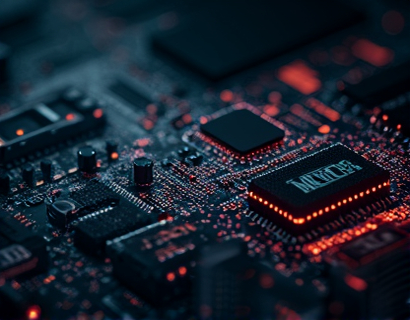Next-Gen Smart Contract AMMs: Revolutionizing DeFi Trading with Advanced Automation
The decentralized finance (DeFi) ecosystem has witnessed exponential growth, attracting a diverse array of crypto traders and enthusiasts. At the heart of this transformation are Automated Market Makers (AMMs), particularly those powered by smart contracts. These innovative platforms are redefining liquidity management and trading strategies, offering unparalleled efficiency and automation. This article delves into the cutting-edge features of next-generation smart contract AMMs, exploring how they are transforming the DeFi trading landscape.
Understanding Smart Contract AMMs
Traditional AMMs rely on algorithms to determine asset prices and manage liquidity pools, eliminating the need for order books and market makers. Smart contract AMMs take this a step further by leveraging blockchain technology to create fully decentralized and transparent trading environments. These AMMs operate on platforms like Ethereum, Binance Smart Chain, and Solana, utilizing smart contracts to execute trades, manage liquidity, and enforce rules automatically.
Smart contract AMMs are built on the principles of open-source code, allowing developers to audit, modify, and improve the protocols continuously. This transparency and flexibility foster trust and innovation within the DeFi community. The use of smart contracts ensures that all transactions are immutable and verifiable, reducing the risk of fraud and enhancing security.
Advanced Automation in DeFi Trading
One of the most significant advantages of next-gen smart contract AMMs is their advanced automation capabilities. These platforms can execute complex trading strategies with minimal human intervention, optimizing returns and minimizing risks. Automated trading bots, often referred to as bots or traders, can be deployed to execute trades based on predefined criteria such as price thresholds, market conditions, and portfolio balances.
These bots can operate 24/7, capitalizing on market opportunities that human traders might miss due to time constraints or emotional decision-making. By automating trading processes, users can maintain a consistent and disciplined approach, which is crucial in the fast-paced crypto market. Additionally, automation reduces the likelihood of human errors, ensuring that trades are executed precisely as intended.
Dynamic Liquidity Management
Liquidity management is a critical aspect of DeFi trading, and smart contract AMMs excel in this area. These platforms offer dynamic liquidity pools that adjust in real-time based on market demand and supply. Users can contribute tokens to liquidity pools and earn liquidity provision fees, which are distributed based on the amount of liquidity provided. This incentivizes more participants to contribute, enhancing the overall liquidity and depth of the market.
Next-gen smart contract AMMs employ sophisticated algorithms to optimize liquidity allocation. These algorithms analyze market conditions and user behavior to allocate liquidity where it is most needed, ensuring efficient price discovery and reducing slippage. This dynamic approach not only improves trading experiences but also attracts more users to the platform, creating a virtuous cycle of growth and engagement.
Enhanced User Experience
The user experience on smart contract AMMs has seen significant improvements, making DeFi more accessible and user-friendly. Intuitive interfaces and user-friendly dashboards allow traders to manage their assets, view market data, and execute trades with ease. These platforms often integrate with popular wallet solutions, enabling seamless interactions and reducing the friction typically associated with DeFi platforms.
Moreover, next-gen smart contract AMMs offer advanced features such as customizable trading strategies, real-time market insights, and comprehensive analytics. Users can monitor their portfolio performance, track market trends, and adjust their strategies on the fly. This level of control and visibility empowers traders to make informed decisions and maximize their returns.
Security and Trust in DeFi
Security remains a paramount concern in the DeFi space, and smart contract AMMs have taken significant steps to address these concerns. By leveraging the immutability and transparency of blockchain, these platforms minimize the risk of centralized points of failure and unauthorized access. Smart contracts are audited by independent security firms, and any vulnerabilities are promptly addressed, ensuring a high level of security.
Furthermore, the decentralized nature of smart contract AMMs reduces the risk of censorship and manipulation. Since there is no central authority controlling the platform, users have greater control over their assets and transactions. This decentralization fosters a trustless environment, where users can interact without relying on intermediaries, enhancing overall trust in the DeFi ecosystem.
Interoperability and Cross-Chain Capabilities
Interoperability is another key feature of next-gen smart contract AMMs. These platforms are designed to work seamlessly across different blockchain networks, enabling users to access a broader range of assets and protocols. Cross-chain bridges and atomic swaps allow for the exchange of tokens between different chains, breaking down silos and creating a more interconnected DeFi landscape.
This interoperability not only enhances user experience by providing access to a wider array of assets but also fosters innovation by enabling developers to build more complex and integrated DeFi applications. As the ecosystem continues to evolve, the importance of cross-chain capabilities will only grow, making smart contract AMMs a crucial component of the future DeFi infrastructure.
Challenges and Future Prospects
Despite the numerous advantages, next-gen smart contract AMMs face several challenges that need to be addressed to achieve widespread adoption. Scalability remains a significant issue, as blockchain networks like Ethereum struggle with high transaction fees and slow processing times during peak usage. Layer 2 solutions and new blockchain platforms are being developed to alleviate these bottlenecks, promising faster and cheaper transactions.
Another challenge is the complexity of smart contracts, which can be a barrier for less tech-savvy users. Educational resources and user-friendly interfaces are essential to demystify these platforms and make them accessible to a broader audience. Additionally, regulatory clarity is crucial for the long-term sustainability of DeFi and smart contract AMMs. As governments and regulatory bodies begin to address the unique challenges of decentralized finance, the ecosystem will become more stable and attractive to mainstream users.
Innovative Features and Use Cases
Next-gen smart contract AMMs are not just about improving existing trading mechanisms; they are also opening up new possibilities in the DeFi space. One such innovation is the integration of yield farming and staking protocols, allowing users to optimize their returns by combining liquidity provision with passive income streams. These platforms can automatically rebalance portfolios to maximize yields, providing a comprehensive solution for crypto enthusiasts looking to grow their assets.
Another exciting use case is the development of decentralized exchanges (DEXs) built on smart contract AMMs. These DEXs leverage the liquidity and automation features of AMMs to create more efficient and user-friendly trading experiences. By eliminating order books and traditional market making, DEXs can offer lower fees and better price execution, attracting more traders to the DeFi ecosystem.
Furthermore, smart contract AMMs are paving the way for decentralized lending and borrowing platforms. By integrating lending protocols with AMMs, users can borrow assets using their liquidity positions as collateral, creating a seamless and secure borrowing experience. This integration enhances the functionality of DeFi platforms, making them more versatile and appealing to a wider range of users.











































